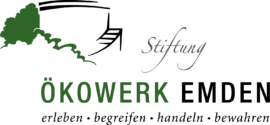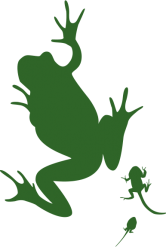Welcome to the Ökowerk Emden!
The Ökowerk is a place to experience nature, for people of all ages. The Ökowerk is a non-
profit foundation.
Our foundation’s purpose is environmental education for children and adults.
Every year we welcome more than 100 groups from local kindergartens and schools. People
from Emden and the entire region can also visit our site at any time to enjoy our premisses.
For opening times check the website. A total of about 25,000 people visits us every year.
These topics are the focus of our educational work: biodiversity, education for sustainable
development, the preservation and reproduction of apple trees from our apple orchard and
the protection of our coast in the face of climate change.
Our educational work takes place mainly outside, i.e. in our garden.
We have an area of about seven hectares here in Borssum, which I would like to show you
right now.
You can discover many differently designed small living areas for animals and plants.
A very special treasure is our orchard, which we call the Pomarium frisiae.
There we have over 600 different varieties of apples. A total of 1000 fruit trees and fruit
shrubs grow there.
Now let’s go into the field together and look at what we have to offer at Ökowerk.
Our little forest.
As you may have already noticed, there are relatively few forest areas in East Frisia. On our
grounds we cherish and maintain a small piece of forest, through which we particularly like to
walk with groups of children.
You can discover here wooden sculptures of typical forest dwellers.
In addition, we can discover bird nests. And we can note that ground cover in the forest can
be very tasty.
At the primary clarifier.
The Ökowerk was created from an old sewage treatment plant. The sewage treatment plant
was closed in the 1980s and the buildings were preserved. The city of Emden had the desire to
build the first environmental education centre in East Frisia here and so it happened. Here at
this old primary clarifier, you can see the first models of nesting aids, which were made and
installed here about 30 years ago.
Our next major project around these old buildings is a barrier-free circular path that will rise
to a height of 6 meters. At the end of the path, visitors will be able to stand on the roof of this
building and look over the entire Ökowerk site all the way to the mouth of the River Ems into
the North Sea.
Our main building
We installed a green roof on our roof 25 years ago. Green roofs have different purposes. On
the one hand, it should help to achieve a better climate inside the house. On the other hand,
it serves as a rain retention basin. Thirdly, it is also a place for various grasses and flowers and
thus a source of food for insects.
Barefoot nature trail
This is our barefoot nature trail. Along this nature trail, children can feel different surfaces
with their bare feet. It is part of the idea that we at the Ökowerk want you, the visitors to
experience nature with all your senses.
The farmer´s garden
At this point we have built a traditional farmer’s garden with four small, different fields. They
were traditionally laid out in the front of the famer`s yard, which were planted differently.
Potatoes, other vegetables, and flowers form the four pieces of the farmer`s garden.
The planting of the individual fields rotates every year. Where flowers are still blooming one
year, potatoes will grow the next, and other vegetables the next. This ensures that the soil
remains fertile for longer if it is planted with different plants every year.
The big greenhouse
Halophytes grow in this greenhouse. These are plants that grow naturally on the salt marsh.
i.e. where the sea water runs over the beach.
Why are we doing this?
It can be assumed that the rising sea level will lead to our farmland becoming more and more
salinized. Which plants will be planted more and more for salts in soil in the future? Our
conventional crops can only tolerate a certain amount of salt. Therefore, a building block of
the nutrition of the future in coastal regions may also be the only thing that grows on the salt
marsh.
Here we tried to recreate the salt marsh in the greenhouse. The salt marsh plants that are
grown here are harvested and put on the menu in a restaurant in Emden. We have shown
that there can be new opportunities for agricultural activities right on the coast behind the
dyke.
Our animals
Various animals live on our premises. We have geese, chickens, pigs, and sheep here. We
show how old house terraces used to be kept around the courtyards. The animals have a lot of
space here and can meet their natural needs.
Pomarium frisiae
Now you have arrived at one of the most beautiful places in the Ökowerk. This is our
Pomarium frisiae, our Frisian orchard. Over 600 different types of apple trees grow here. A
total of about 1000 fruit trees and fruit bushes grow here. I’m not a specialist in pomology. I
just want to give you the opportunity to walk around the Pomarium a little bit and in 10 to 15
minutes I would ask you to come to the big green greenhouse. Then I would like to tell you
about the preservation of ancient apple varieties and our goal here at Pomarium.
For any further questions, please contact
Dr. Katharina Mohr, Geschäftsführung, mohr@oekowerk-emden.de


